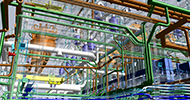In a previous blog, we explored how COVID-19 accelerated digital transformation. This shift towards greater connectivity and digitally-enabled working can be seen throughout manufacturing. Now organisations are benefitting from the smart transformation of service and support.
Traditionally, when an operator contacted their service and support provider about a complex issue with their machine, they might have had to wait for an engineer to come and fix the problem in their facility. That meant downtime and interruptions to productivity were subject to geographical distance, not to mention flight delays and road traffic!
Of course, this traditional approach became very difficult, if not impossible, in 2020. The health risks and varying national regulations on social distancing meant that service and support teams needed to innovate to help manufacturers fix issues and maintain business continuity.
Thankfully, digital innovation has made the world smaller, and we can connect through technology to solve customer issues. For our service and support clients, this has resulted in a more efficient form of working.
Now we are using the latest augmented reality (AR) technology to help manufacturers quickly and accurately fix machine problems. Here’s how it works: the operator uses a mobile device to livestream the machine via video. Thanks to AR technology, the technician can highlight, draw on and add annotations to the screen in real-time so the user knows exactly what to do to solve the issue, all the while guiding the customer with expert advice.
Let’s say a manufacturer based in South Korea needs to fix a machine that was manufactured in Italy. In the past, waiting for an expert technician to arrive at their factory could take days. But AR technology provides a premium service of global expertise by connecting manufacturers, wherever they are, to Hexagon’s worldwide expert engineers. For manufacturers, this remote service means time-saved not having to wait for site visits and reduced machine downtime. So in this example, taking into consideration the potential difficulties of diagnosis and extended consultation, the time-frame for fixing the problem via site-visit could be a matter of weeks; the new, virtual approach reduces this to a matter of hours.
They will also see an increase in their first-time fix rates, which can result in major cost-savings. There’s also significantly less chance of human error as the user is being supported with the same level of expertise as an in-person engineer would provide. Of course, such timely fixes can help prolong the service life of the machine.
Reducing the need for unnecessary travel is also a clear win in an era where sustainable business practices are increasingly important. Rather than increasing carbon footprints with air and road travel, users can access technical support, quick-fixes, and a vast reservoir of knowledge at the push of a button.
The benefits even go beyond repairs and maintenance. The operator receiving instruction and making the fixes gains skills in repair and maintenance. This vicarious training can also be extended to other team members. The real-time interactions via video can be recorded, enabling manufacturers to re-use the videos as training resources.
Watch the video below for a quick overview of the capabilities of this innovative AR technology and how it can transform your service and support experience. To learn more, contact your local Hexagon service team.














